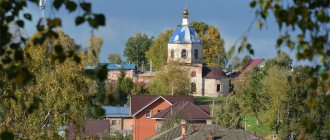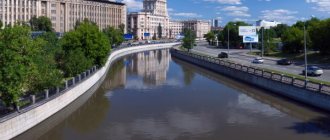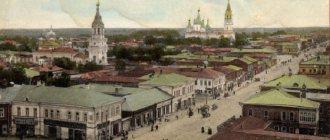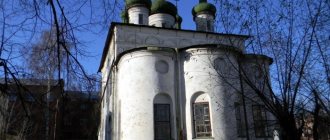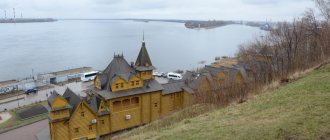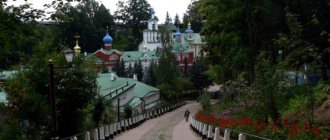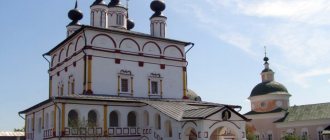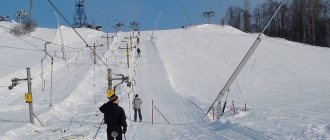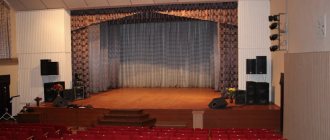The village of Ruzskoye is mentioned for the first time in the will of Prince Kalita. The settlement, according to historians, had already existed for several centuries by that time. The fortress city of Ruza often stood in the way of the enemies of the Russian state: it was swept off the face of the earth by the hordes of the Tatar Khan Tokhtamysh, and unsuccessfully besieged by the troops of the Polish prince Vladislav.
By the 19th century, Ruza had become a typical provincial town with small factories: spinning, brick, leather. The city center is being built up with stone and wooden mansions by merchants and wealthy townspeople. A hospital opens and educational institutions begin to operate: a zemstvo school, a real school, and parochial schools.
The city lives a leisurely, familiar life. But 1917 comes, and again Ruza finds herself in the thick of historical events. However, the city suffered the most at the beginning of the war, when it was occupied by fascist troops, some buildings were destroyed, and many residents died.
What interesting things to see around Ruza or on the way to it? Curious cities - Mozhaisk and Zvenigorod, Pushkin museums, Vadim Zadorozhny's equipment, Arkhangelskoye and other places in a detailed guide to the Moscow region.
The importance of the city in the modern world
The first mention of Ruza dates back to 1328 in the will of I. D. Kalita. In the chronicles, many lines were devoted to this place. It was this city that was the main outpost of the Moscow lands, which held back the military forces of the Smolensk, Novgorod and Tver principalities.
Historians agree that this place got its name from the river Ruza, which flows nearby. Translated from Latvian, the word “ruosa” means a stream located among forests and fields. In 1761, the settlement was given a coat of arms, and in 1782 it was given the status of a district town of the Moscow Province. Officially, the area of Ruza is 17.38 km².
Borders the following rural settlements:
- In the northwest with Ivanovsky.
- In the northeast with Volkovsky.
- In the southwest, south, southeast with Staroruzsky.
Location of Ruza on maps:
- North latitude: 55° 41ˊ 56״̋ (55° 41' 93).
- East longitude: 36° 11' 42″ (36° 11' 71).
The economy of Ruza consists of the following sectors:
- Food industry (dairy and bakery plants, distillery).
- Printing department.
- Furniture company.
- Garment factory.
Starting in 2021, residential buildings are being built in Ruza to resettle city residents from dilapidated houses into safe housing.
Cathedral of the Resurrection of the Word
In the center of Ruza, on Partizan Square, the gilded domes of the five-domed Resurrection Cathedral, the oldest building in the city, shine. The tall stone structure with a refectory and bell tower was erected at the beginning of the 18th century, and in the mid-19th century it was rebuilt in the pseudo-Russian style. The entire interior of the church was decorated with paintings; the ringing of 6 bells, the largest and most sonorous in the county, could be heard far above the city and its surroundings. In the 1930s, the cathedral lost its domes and bell tower, and its premises were used as a cinema and a children's sports school. Only in 2009 was the temple returned to believers and restored; work to restore its interior decoration is still underway.
Address: Teatralny lane, 17.
Cathedral of the Resurrection of the Word
Climate
The climate of Ruza is moderately cold. The warmest month according to statistics is July. Its average air temperature is +18°C. The coldest period is January. The thermometer at this time is -9.3°C.
Weather data in Ruza by month:
| Month | air temperature during the day | air temperature at night | Humidity (in%) | Amount of precipitation (in mm) | Number of clear days | Number of days with prolonged precipitation | Number of days with partly cloudy conditions |
| January | -8 | -10 | 89 | 43 | 1 | 6 | 24 |
| February | -4 | -6 | 91 | 43 | 1 | 6 | 22 |
| March | +2 | +1 | 89 | 54 | 1 | 7 | 23 |
| April | +9 | +3 | 77 | 57 | 5 | 7 | 18 |
| May | +17 | +11 | 69 | 80 | 9 | 9 | 13 |
| June | +20 | +13 | 66 | 78 | 9 | 8 | 13 |
| July | +23 | +15 | 68 | 87 | 12 | 8 | 11 |
| August | +21 | +14 | 68 | 56 | 10 | 5 | 16 |
| September | +15 | +11 | 78 | 54 | 5 | 4 | 21 |
| October | +7 | +4 | 85 | 58 | 2 | 6 | 23 |
| November | +1 | -1 | 89 | 60 | 1 | 7 | 22 |
| December | -4 | -5 | 91 | 57 | 0 | 8 | 23 |
Weather data is based on meteorological studies over the past 10 years. Starting from 2021, a slight warming of the climate has been observed in Ruza.
Monument to Zoya Kosmodemyanskaya
In 2013, a monument to Zoya Kosmodemyanskaya, a young Soviet partisan and the first woman awarded the title of Hero of the Soviet Union, was unveiled in front of the city House of Culture.
The 4.5 m high bronze monument was not installed in Ruza by chance: nearby, in the Ruza district, is the village of Petrishchevo, where the Nazis executed Zoya in November 1941. The sculpture was donated to the city by the Russian Military Historical Society, the author of the monument is Zurab Tsereteli.
Wikipedia.org
Ecology
The ecology of Ruza and the surrounding lands is favorable. It’s not for nothing that this place is called the “Second Switzerland”. There are many birch, pine and aspen forests, as well as ponds, around the city. These factors make the air in Ruza clean.
The absence of industrial giants and relatively low human population have a beneficial effect on the local ecology. Since 1994, Ruza has been included in a program to maintain the purity of the natural environment. This made it possible to reduce harmful emissions into the atmosphere. The assessment of the ecology of these lands according to specialists from the research institute is especially clean.
Population
The population, according to the 2021 census, is only 12,793. For the first time, the Vyatichi began to settle on these lands. They came here from the southwest side. A little later, part of the Krivichi settled here, who arrived from the north-west.
An interesting fact is that the Slavs came to Ruza already inhabited. Moreover, the previous residents were its invaders. This fact is evidenced by the foreign names of these places. Ruza is a derived Baltic word meaning stream.
Don't miss the most popular article in the section: Metro Nizhny Novgorod. Diagram, map, description.
Church of the Intercession
Address: Sotsialisticheskaya str. Telephone: (49627) 2-49-44 Opening hours: 8.00 -19.00
Written sources reported about this temple at the beginning of the 17th century. The Watch Books stated that the building had repeatedly deteriorated and collapsed. And in 1781, thanks to the merchant G. Nesterov and the landowner N. Artsibashev, a stone temple in the Baroque style was erected. A four-tiered bell tower rose near the church. Currently, the premises of the city museum are located on the ground floor, and religious services are held on the second floor.
Flora and fauna
The nature of Ruza is distinguished by a wealth of species of flora and fauna. It is interesting that more than 320 million years ago there was no land on the site of this city. Here were the waters of a large sea basin. This is evidenced by numerous geological finds.
Currently, the following species of animals and birds live here:
- Black polecat.
- Carp.
- Muskrat.
- Otter.
- Pine marten.
- Raccoon dog.
- Chipmunk.
- Beaver.
- Boars.
- Foxes.
- Wolves.
- Boars.
- Geese and ducks.
The flowing Ruza River is inhabited by:
- Dace.
- Pike.
- Roach.
- Ide.
- Crucian carp.
- Guster.
- Perch.
- Tench.
- Asp.
- Chub.
- Zander.
- Carp.
Ruza (the sights of this place are famous for its clean air) is rich in spruce forests, conifers, willows, and aspens.
There are a lot of plants growing here that are classified as protected species:
- Lady's slipper.
- Long-horned kokushnik.
- Prince.
- The cache is ovoid.
- The skirt is double-leafed.
- Fuchs orchis.
- Dremlik swamp.
Also in large quantities you can find peach-leaved bells, wavy sedge, drupe, sorrel, European hoofed grass, golden rod, and wolf's bast.
How to get there
Ruza is located near the capital of Russia. You can get there from Moscow by bus (the trip will take 2 hours). Route No. 455 departs from the Tushinskaya metro station. You can get to the main attractions on foot or by public transport (bus).
By train
From Tuchkovo, Begovaya and Belorussky railway stations (Moscow) you can get to the Tuchkovo stop, and then transfer to a minibus or bus.
By car
Moving along the Minsk highway from Moscow (via Dorokhovo) you need to get to the sign for Ruza. This section of the route takes approximately 84 km. After the sign for Ruza, you should turn right and follow the main road.
Another route to Ruza by car runs along Novorizhskoye Highway. You should follow it until the sign for the interchange “Volokolamsk, Pskov, Ruza, Minsk”. You need to take the 2nd ring and move to your destination.
Types of transport in the city
The only type of public transport that exists in the city of Ruza is buses. There are minibus taxis that do not have a positive characteristic. Flights operate regularly both within the city and beyond.
Tourists can easily use car rental services. For example, a Skoda Rapid will cost 1900 RUB. in 1 day. You will have to leave 9 thousand rubles as a deposit; driving experience does not play a role.
Main attractions
Ruza sights have both cult and natural significance. Each of them has its roots in the distant past of this place.
Religious buildings
There are many more religious buildings in Ruza than museums. One of the most visited here is the Cathedral of the Resurrection of Christ. It can be found at: st. Partizan, 1. The date of construction dates back to the 18th century. Previously, there was a church here, the construction of which dates back to the times of Polish-Lithuanian clashes.
Ruza, religious attractions opens the Cathedral of the Resurrection of Christ
The cathedral was destroyed and reconstructed more than once before it acquired its current appearance. An interesting fact is that there is a chapel next to it. Next to it is a burial place of people who in ancient times became victims of the plague. Another ancient religious building is the Church of Demetrius of Thessalonica.
You can find this place at st. Dmitrovskaya, 22. The first mention of the church in chronicles dates back to the 16th century. The temple was destroyed during the war with the Poles, and then restored due to the investments of philanthropist M. Bryushkov and Arsenyeva (in 1792). The new building was built of stone in the Baroque style.
The Church of the Intercession also attracts tourists. You can find her on the street. Socialist. The building dates back to the 17th century. The church building changed gradually. In 1781, a bell tower consisting of 4 tiers was added to it. The building itself was also changed and acquired features of the Baroque style. This became possible thanks to N. Artsibashev and G. Nesterov, who sponsored the work.
On the 1st floor of the church there is currently a museum that everyone can visit.
In addition to churches, there is the Vasilyevskaya estate. She is located next to Ruza. The easiest way to get to the place is from the station. Kuntsevskaya metro station by bus No. 421. The time of construction dates back to the middle of the 19th century. In its heyday there was a zoo, greenhouses, and orangeries.
During dispossession, the estate building was given over to a sanatorium. On the territory of the estate there is the Church of St. Panteleimon, in which there is the tomb of Prince Shcherbatov. Now this place is only accessible for external inspection. Restoration work is underway throughout the area and inside the buildings.
Museums
In Ruza, you should definitely visit the regional museum of local lore. It was located on the street. Partizan, 14. Its opening hours are from Wednesday to Sunday from 9.00 to 17.00. The entrance ticket price for school-age children is 10 RUB, for an adult – 20 RUB.
RKM is considered the oldest museum in the Russian Federation. Its main exhibitions were formed after 1917. At that time, valuable exhibits from the estates adjacent to Ruza were brought here. During the Second World War, most of the collection was destroyed or looted. All Ruzhan residents restored it - they brought what could be of historical value.
Currently the museum's exhibition is presented by:
- Archaeological finds.
- Household items of peasants who worked in Ruza.
- Historical photographs.
The second most important museum in Ruza is the Historical Police Museum. You can find it on the street. Solntseva, 18. Open from Monday to Friday from 10.00 to 13.00. Visiting is free for all categories of citizens. The museum building previously belonged to a temporary detention facility, and therefore one can truly feel the atmosphere corresponding to the name of the place.
In the exhibition you can see:
- Weapon.
- Equipment and uniforms of the 2nd World War.
- A gun designed according to plans by Leonardo da Vinci (the age of the exhibit is dated to the 16th century).
- Criminal cases of past years.
- Historical information about police heroes.
- Unusual things of prisoners.
There are no more museums in Ruza. However, 38 km from it is the village of Petrishchevo. There is a house-museum of Zoya Kosmodemyanskaya, a famous Soviet partisan who was executed by the German occupiers. This place is open from 10.00 to 18.00. The exhibition is dedicated to the life and work of Zoya. You can get here by bus No. 45 “Bus station Ruza - Luninka”.
Regional Museum of Local Lore
Address: Partizan Square, 14 Telephone (49627) 2-34-83 Website: https://www.ruzamuseum.ru/ Opening hours: 9.00-17.00; Closed: Monday, Tuesday Cost: adult: 20 rubles, schoolchildren: 10 rubles
The oldest museum in Russia, opened in 1907. The main collections were formed after 1917, when valuables from surrounding estates were brought to the museum. During the occupation, the collections were destroyed, but after the war, thanks to the townspeople, the museum was rebuilt. Almost all exhibits are a gift from local residents.
The museum's exhibition is dedicated to the history of the local region. It includes an archaeological collection, a small collection of paintings, weapons, as well as exhibits telling about the culture and life of local peasants and landowners. The museum stores unique postcards, photographs, negatives with images of old Ruza.
Monuments
At the intersection of Pedestrian and Federative streets in Ruza there is a monument to Mishka Karas. Many people remember him from the TV series "Liquidation". Although the plot of the film describes Odessa, the boy hero is from Ruza, which he mentions in one of the frames. M. Tarkhanov, the head of the district administration, was present at the opening of the monument. In a solemn speech, he emphasized the significance of this structure.
He personifies the entire generation of children during the Second World War who saw all the horrors of war. The author of the monument is A. Romashevsky, Honored Artist of the Russian Federation. There is a Walk of Fame in Ruza, where you can see monuments to the heroes of the battle near Moscow. You can find this place near the former Polushkino sanatorium. One of the significant places is the monument to paratroopers.
Its opening took place in 2009 on the 20th anniversary of the withdrawal of armed forces from Afghanistan. The structure consists of a pedestal and a BMD-2 mounted on it. On it is the inscription-motto “Nobody but us.” On the sides of the monument there are 2 granite slabs with the names of the paratroopers from Ruza who died in hot spots. This monument is located next to the stadium.
The Second World War did not spare Ruza. There are burial places of 370 people in this city. A monument was erected on the site of the mass grave. You can find this place near the Gorodok park. Next to the public reception of United Russia there is a monument to the victims of political repression.
Near the 2-storey hotel there is a boulder monument, personifying the power and strength of the “Defenders of the Ruz Land”. Near the chapel of Pantileimon there is a small monument to the Russian new martyrs. It is fairly new - installed in June 2017.
Ruza
origin of name
The city of Ruza got its name from the river on which it was built. It is difficult to say from what word the name “ruza” originated. According to one version, it comes from the root “rub” or from the word “to chop.” The word “cut,” in turn, comes from the word “border,” that is, something separated, “cut off.” The word “rubezha” (once it was feminine) was gradually shortened to “rubzha”, after which it turned into “ruzu”.
First settlements
Archaeological excavations carried out over thirty years have shown that the territory of the Ruza region was inhabited by people in ancient times. The first sites appeared here in the Paleolithic (Stone Age). Archaeologists concluded that these sites belong to the Stone Age due to the fact that mammoth bones were found at the site of the settlements, which Stone Age people used to build their homes. It is assumed that the first settlers came here from the Dnieper. In the Zarechnaya part of modern Ruza there is a burial ground known as Gallows Mountain. It is considered one of the first evidence of Fatyanovo residents living in this area. This is the name given to the first people who settled on the territory of the modern village of Fatyanovo. More than two thousand years ago, tribes of the Baltic peoples and Finno-Ugric peoples lived in the territory of what is now the Moscow region. The Baltic people lived in the Moscow River basin. These tribes already knew how to mine iron and prepare various alloys. The Balts exchanged metal products for the goods they needed from neighboring tribes. The Baltic tribes preferred to settle on hills, building ancestral fortresses here. From the heights it was much easier to withstand the attacks of a suddenly appearing enemy or the attack of wild animals.
The perimeter of the famous Ruza settlement exceeds 1 kilometer. There is an isthmus with two ditches. Archaeologists have discovered a complex system of entrances. The thickness of the cultural layer is from 1 to 6 meters. This settlement is one of the main archaeological monuments of the Moscow region. Since the 1970s, this monument has been under state protection and is considered a monument of feudal significance. The use of the Ruza settlement is regulated by a special law on the protection of historical and cultural monuments.
Foundation of Ruza. City XIV–XVIII centuries
The emergence of Ruza is associated with the construction of guard fortresses. The fortifications were built in such a way that they formed a ring, within which a settlement arose. The development of the new city was hindered by the Tatar-Mongol invasion. The young city shared the fate of several of its neighbors, including Moscow. Further development of Ruza continued only in the 1300s. After the Moscow principality became independent, Ruza became a border fortress. Under Ivan Kalita, intensive construction was carried out in the city, as evidenced by excavations led by Golubeva. Construction work was aimed at strengthening Ruza's combat capabilities. Since there is no exact date for the establishment of the city, the official date is considered to be the date of Ivan Kalita’s will. In this document you can find the phrase “city of Ruza”. It is impossible to find any mention of the city in earlier documents. Some scientists believe that Kalita's will dates back to 1328. Others believe that the document was drawn up in 1339. Together with such cities as Mozhaisk and Kolomna, Ruza contributed to the formation of the Moscow state.
According to Kalita's will, Ruza went to his son Ivan Ivanovich, who, in turn, passed it on to his son Dmitry, who went down in history under the name Dmitry Donskoy. Thus, the city reached the grandson of Dmitry Donskoy, Dmitry Shemyaka. After the death of Shemyaka (there is an opinion that he was poisoned), Ruza comes into the possession of the Moscow prince Vasily the Dark. From Vasily the Dark the city passed to his son Boris, who passed Ruza to his son Ivan. After Ivan's death, the city again returned to the Moscow prince. Ivan the Terrible gave Ruza to the Tatar prince Simeon Bekbulatovich. A year after this event, Ruza, along with its surroundings, was included in the oprichnina. During the reign of Ivan the Terrible, Ruza retained its military purpose.
The time of troubles did not bypass Ruza. It is known that the residents of this city supported the uprising of Ivan Bolotnikov. The Time of Troubles pretty much devastated the city and its surroundings. In these places, Polish-Lithuanian detachments were actively engaged in robbery. In 1610, Hetman Zholkiewski approached Moscow. Residents of the capital and neighboring settlements had no choice but to swear allegiance to Vladislav Sigismundovich, the son of the Polish king. However, when in 1617–1618 Prince Vladislav launched a campaign against Moscow and approached Ruza, its inhabitants did not submit to him. The city was too well prepared for defense. It was impossible to take him by attacking unexpectedly. At least three hundred people took part in the defense of Ruza. An underground passage was dug and ammunition was prepared. The city residents also stocked up on provisions. The Poles destroyed everything except the fortress, which they could neither take nor burn. Despite the fact that the unconquered Ruza suffered greatly, the residents of the city managed to rebuild it in the shortest possible time.
But in 1619, a new misfortune happened: the city was almost completely burned down during a fire. Residents of Ruza turned to Tsar Mikhail Fedorovich. The king exempted Ruza from paying all taxes for 4 years. Thus, the tsar rewarded the Ruzhans for their courage shown in the battle with the Poles.
In the second half of the 17th century, Ruza gradually began to lose its military significance. The famous fortress, which had survived the fight against the invaders, began to collapse. The military significance of the Ruza fortification was remembered during the reign of Peter I, when the reformer tsar began a war with the Swedes. A small garrison was even sent to Ruza. But after the Swedes were defeated, the Ruza fortress completely lost its military purpose. Residents dismantled the fortress and settled on the town's streets. The city, however, did not cease to exist. Ruzhany were engaged in agriculture, crafts and trade. Under Catherine II, a plan for the general development of the city was created. The plan provided for the construction of rectangular blocks in the city and turned out to be very successful. All city administrative buildings were located in the very center of Ruza. At the same time, noisy market squares were moved to the very outskirts of the city.
City architecture
Russian architecture cannot leave indifferent even those who do not understand architecture. In Ruza, buildings that appeared in the city even before the 1917 revolution are still preserved. They were not harmed even during the Great Patriotic War. Most of these are buildings from the 19th century. On Socialist Street you can see a building that locals call the “House of the Black Lady.” You can also remember the buildings on Partizan Square. Many of the buildings located here were built at the beginning of the 19th century. Merchant houses and the building in which the mayor lived appeared only in the second half of the century. The mansion of the Moscow businessman Leontyev will certainly interest visitors to the city. This structure was made by Finnish carpenters in Vyborg. The mansion is designed in wooden modern style. This style is typical mainly for the Baltic states. The building was constructed at the turn of the 19th and 20th centuries. The amazing mansion was moved to Ruza in 1908. Today this magnificent building houses the House of Children's Creativity.
Ruza churches are no less beautiful than other city buildings. In the 18th century there were at least four churches in the city. One of these churches was the Cathedral. One of the oldest buildings in Ruza is the Resurrection Cathedral (today this building houses a sports school). The old Resurrection Cathedral was replaced by a new one. The Resurrection Stone Cathedral was founded under Nicholas I. The one that replaced it was significantly expanded. Next, the Church of the Intercession was built on the settlement. In addition, there was also a dilapidated wooden church in the settlement, which was replaced at the end of the 19th century by the Church of Dmitry of Thessalonica, built of brick. And the youngest Russian church is considered to be the church dedicated to Saints Boris and Gleb on Posad. A wooden temple once stood in its place.
Ruza during the Patriotic War of 1812
Residents of Ruza knew firsthand about the military actions of 1812. A regiment of zemstvo militia was formed in the city. Every tenth resident of Ruza district was called up to fight the French. Most of the warriors were armed with pikes. The militia included not only soldiers from Ruza itself, but also from neighboring counties. The stepson of Napoleon Bonaparte, Eugene Beauharnais, visited Ruza district. His corps received orders to march north that night when the Battle of Borodino ended. Beauharnais began its movement early in the morning. The actions of the French corps worried Kutuzov extremely. Thanks to Cossack intelligence, the Russian military command was able to find out that the French corps of Beauharnais was approaching Klementyev. A cavalry group was sent to the corps. On the third day, the French reached the small settlement of Brynkovo. Here they stood for no more than two hours, waiting until the Bavarian riflemen, working for the French army, could break the resistance of the inhabitants of Ruza.
The French corps managed to occupy Ruza. Most of the corps remained a little west of the city. The Ruzhans managed to take prisoners, who reported that the French plans included moving towards Zvenigorod. Gradually the French captured the entire Ruza district. But already 3 days after the district was occupied by the enemy, local peasants begin an independent fight against the enemy. The French were ordered to double their security. However, fighting the peasants was not so easy. They were dressed like ordinary farmers and could not arouse suspicion. The peasants knew the terrain very well, which means they could attack a small enemy detachment unexpectedly and deal with it without much difficulty. Most often, no prisoners were taken. The peasants intimidated the French so much that the enemy troops, gripped by panic, without waiting for orders from the command, decided to leave Ruza district.
The city in the 19th – early 20th centuries.
The next important event for the Ruz lands was the abolition of serfdom. Landowners' estates and industries began to decline. But the plants and factories of the merchant and bourgeois classes flourished. A brick factory owned by the Parshin family was built in Ruza itself. Leather production also appeared. The enterprises were small, sometimes employing no more than ten people. Significant changes have also occurred in the education system. In addition to parochial schools, two-year zemstvo schools are beginning to appear in the district. Medicine was also given attention. Medical institutions were financed from the county treasury and through charity. Almshouses appeared. The district intelligentsia was engaged in public education free of charge. In Ruza district, libraries and the Ruza district zemstvo society of popular sobriety appeared, which was engaged in the dissemination of educational literature.
In the “List of populated places of the Moscow province” for 1862, Ruza is listed as a district town of the Ruza district along the Ruza River, 94 versts from the provincial city of Moscow. The city had 377 houses and 3,180 residents of both sexes - 1,548 males and 1,632 females. Indicated: 4 Orthodox churches, 3 schools (parish, district and women's), hospital, postal station, factory, 4 factories.
In 1903-1906, work was carried out in the city to create a city park. The Ruza Local History Museum began the history of its existence from a small room in the city library. Several interesting exhibits were collected here, which became more and more numerous over time. When the exhibits occupied the entire building, it was decided to open a museum.
In 1917, Ruza became a Soviet city. In the first years of Soviet power, the main task of the new city leadership was to take care of public health, which was significantly undermined during the war and revolutionary upheavals. Particular attention was paid to the health of children, for whom health colonies were created in the vicinity of Ruza. In the 30s, the study of climatic and geographical features of the Moscow region began. Experts have come to the conclusion that Zvenigorod, Ruza and some other cities in the region are suitable for the construction of health resorts. Research was interrupted by the Great Patriotic War.
During the Great Patriotic War
During the war years, the life of the area was “put on a war footing.” In the summer of 1941, a fighter detachment was formed in Ruza, divided into 2 divisions - Tuchkovskoe and Ruzskoe. The detachment was supposed to patrol the Ruza region and identify spies and deserters. The team's work was very successful. During the patrol, a huge number of deserters and fascist spies were identified. The most significant was the capture of German intelligence resident Blodo.
The population of the city and region was engaged in the construction of defensive structures. Ruza was of considerable value to the Nazis because of the roads that branched off from it, connecting the area with strategically important objects. The Nazis managed to enter the Ruza region. The enemy entered the city along the Dorokhovskoye Highway. Thus began the occupation of the Ruza region. The Nazis used the city and region as a place for regrouping military units. There were repair shops, ammunition depots and communications here. The partisan detachments tried to obtain as detailed information as possible about warehouses and workshops. During the occupation, all cultural institutions and outbuildings in the city were destroyed. The total damage caused by the Nazis amounted to at least a billion rubles. Most of the damage was caused not by fighting, but by robbery and robbery by the occupiers. Soviet troops were unable to recapture the city the first time. Only in January 1942, after prolonged fighting, the occupiers were finally expelled.
Post-war period
After the liberation of the area, the population began to restore the economy. Administrative bodies resumed work, and preparations for the sowing season began. The military destruction was completely eliminated only in 1947. Immediately after the end of the war, climate studies of the area resumed. Healing mud and mineral waters were discovered in the region. One of the first health resorts was the Serafimovich Writers' Creativity House. The health resort became a resting place for Moscow writers. In addition to numerous health resorts, pioneer camps were also built. Private construction was also widespread. Many dachas are appearing in the Ruza district, which have become a favorite vacation spot for Muscovites.
In 2005, the urban settlement of Ruza was formed in the Ruza region. It includes only one settlement - the city of Ruza itself.
Leisure
Ruza (attractions are often of interest to lovers of passive pastime) offers various options for active recreation. In the surrounding forests you can go on a “quiet hunt” in the fall – picking mushrooms. Boletuses, milk mushrooms, and boletus mushrooms grow here in abundance. There is also a hunting ground here, which is very popular among residents of the Moscow region.
For example, you can shoot an elk for 40 thousand rubles. A license to hunt an adult wild boar costs less - 18 thousand rubles. Near Ruza there is a fishing club “Fishka”. It’s easy to get to this place - an asphalt road leads all the way to the gate. You need to move to the village of Petryaikha, Ruza urban district.
On the territory of "Chips" there are:
- Well-appointed houses.
- Gazebos.
- Car parking.
- Flowing pond system.
This place is located 76 km from Moscow. The cost of fishing for 1 person is 2.3 thousand rubles. For extreme sports enthusiasts, Ruza has a great place to tickle their nerves - the Aeroclassics aviation and sports club. It is located 97 km from Moscow. You can find it in Ruza near the Vatulino airfield.
Jumps from heights that you can try at Aeroclassics:
- Sports (wingsuit, canopy, classic, canopy and group acrobatics, canopy piloting). Athletes can choose a separation altitude from 1.2 to 4 thousand m. The aircraft used for these maneuvers are AN-28 or AN-2.
- With an instructor.
- Independent.
With parental permission, children over 14 years old can also jump. In this case, the altitude will be from 600 to 900 m. A D-6 landing parachute will be used for the maneuver. The cost of services at Aeroclassics starts from 9 thousand rubles.
Interesting places to relax with children
Ruza (the attractions will not be too interesting for children) offers very modest options for recreation with children and schoolchildren. Here you can walk along the streets of the city or look into the Gorodok park. Not far from Ruza there is an interesting place that you can visit if you wish - this is the “Deer Petting Zoo”. Its visit is absolutely free for children under 3 years old.
They can get to know the deer and pet them. You can get here from the Ruzskie Prostori checkpoint. From here you should turn left and drive to the nearest village. From there you need to follow the main road until you turn left. After the sign: “Beware of deer” appears, the farm itself with these animals should appear.
Excursions
You can explore Ruza on your own or as part of a tour group. The second option would be more correct, because this city has many interesting facts in its history.
Sightseeing tour of Ruza
The starting point of the excursion is the Ruzsky Museum of Local Lore (it also hosts this event).
After this, the route will pass through the following historical places of this city:
- Shopping rows.
- Resurrection Cathedral.
- Zemstvo building.
- The oldest street.
- Ruza fort.
- Temples: Intercession of the Mother of God, Demetrius of Thessalonica, Borisoglebsky.
- House of the "Black Lady".
Tours are only available for groups and by appointment. The cost of the event is from 400 to 750 rubles.
Ruza – city of 2 seas
The duration of the excursion is approximately 10 hours.
The event program consists of:
- A walking route along the “Gorodok” – an ancient section of Ruza.
- Visit to Volynshchino - the estate is available for inspection only in the summer.
After this, the tour will continue outside the city. In Komlevo there will be a visit to the Church of the Icon of the Mother of God. In Lyzlovo there will also be a tour of the temple complex. The cost of an adult ticket is 1250 rubles, a child ticket is 1.2 thousand rubles. Tourist bus travel is already included in the price.
One-day excursion around the Ruza expanses
Duration of the program is 12 hours.
It includes visiting places:
- Tuchkova.
- Kolyubakina.
- Ruzy. There will be a sightseeing tour + a walking tour along the ancient street, the ancient settlement and a trip to the local history museum.
- Komlevo.
- Dorokhovo.
The tour ends with arrival in Moscow. Ticket price – 1590 RUB.
Route for exploring the city on your own in 1-2 days
You can explore Ruza on your own based on the following route program:
- Church of the Intercession. Located on Socialistheskaya Street.
- After visiting the temple, you should walk along the street. Krasnoarmeyskaya. It will lead to an ancient settlement, the date of its foundation dates back to the 14th century. Here you can admire panoramic views of the city.
- After this you need to move to the street. Dmitrovskaya. There is a 19th century church here. them. Demetrius of Thessalonica.
- After this you need to go to the street. Solntseva. The police museum is located here.
- After visiting the museum, you should return to the street. Dmitrovskaya and walk to Partizan Square. There is the Cathedral of the Resurrection of Christ and the Ruza Museum of Local Lore.
Finally, you can enjoy the clean air in the Gorodok recreation park.
Settlement
Address: Krasnoarmeyskaya str.
The settlement is located in the city center. To create fortifications in the 14th century, they used a natural hill and the bends of three rivers. The Ruza fortress was considered one of the most impregnable. It had an earthen rampart on which a wooden fort with six towers was erected. The fort's fortifications, powerful at that time, helped repel the advance of Polish troops. But soon after this the fortress burned down.
In the 19th century, the site of the fort was put in order, cleared and a park was planted. The earthen ramparts and remains of the fortress pond have survived to this day, from where the defenders of the fortress took water during the siege. There were such ponds in many Russian fortresses. And now, when it rains, the pond fills with water. From the ramparts you can admire the picturesque panorama of the surrounding area.
Hotels
You can stay in Ruza in hotels and private guest houses. Prices here are relatively low compared to the Russian capital.
Forward
It is located 64 km from Vnukovo Airport and 79 km from Sheremetyevo. The hotel has a restaurant, parking and a children's playground. The rooms are divided into different categories from standard rooms to apartments. Accommodation will cost from $38 to $83 per night for 1 person.
Included in the price:
- Bathroom.
- TV.
- Kettle and coffee maker.
- Soundproofing of rooms.
- Iron.
- Closet.
- Cleaning and hygiene products.
- Hair dryer.
- Towels.
- Bed sheets.
For an additional cost you can order:
- Skiing in winter.
- Fishing.
- Excursions.
- Transfer.
- Pets allowed.
Check-in to rooms from 13.00 to 23.00. Departure before 12.00. Located 6 km from Ruza in the village of Vorobyovo 7A. You can get there by bus from Moscow.
Guest house Guest house Aviator
Located at: SNT FILI Ruza. Cost of accommodation is $75.
This price includes:
- Living room with 1 large bed.
- Bedroom with 1 double bed.
- Balcony.
- Bathroom.
- Sanitary supplies.
- Electric kettle.
- Internet.
- Free parking.
For an additional fee you can use:
- Steam room or sauna.
- Barbecue accessories.
- Laundry room.
- Bicycle rental.
Check-in to the room from 12.00 to 13.00. Departure from 9.00 to 10.00
Guest House Apart-Ruza
Located at: st. Spring 1. Finding this place is quite easy. It is located just opposite the Ruza Aquatic Sports Palace. The cost of placement is from $38.
The rooms have:
- TV.
- Bathroom.
- Wireless Internet.
- Cable TV.
- Toilet.
- Closet.
- Fridge.
- Kitchen.
- Lunch corner.
- Electric kettle.
- Kitchenware.
- Plate.
- Bed linen and towels.
For a fee, you can use the service of food delivery to your room. Check-in is from 14.00 to 23.00. Check out until 12.00.
Museum of the History of the Ruza Police
Address: Solntseva str., 18 Opening hours: 10.00-13.00, closed: Saturday, Sunday Cost: free
Departmental museum, opened on the initiative of veterans of internal affairs bodies. The museum occupies one of the premises of the regional police department, which previously housed a temporary detention center, which helps create an appropriate atmosphere.
The display cases contain exhibits telling about the activities of the police: weapons, uniforms, equipment from the war. The central exhibit is a 16th century gun, made according to the drawings of Leonardo da Vinci.
What to bring as a souvenir
You can buy the following souvenirs in Ruza:
- Products made of stone and wood. Shop “Tenth” (Sotsialisticheskaya St., 61).
- Bracelets, stone crafts. Shop "Ruzskaya Yamsha" (Solntseva St., 5A).
- Items with Russian motifs. “Souvenir and gift shop” (Partizan St., 5).
To see the beauty of Russian nature, you don’t have to go to remote corners. Ruza, located near Moscow, will surprise you with the age of its attractions and their rich history. This place is one of the most environmentally friendly in Russia. Therefore, rest here can be equated to a therapeutic and recreational option.
Article design: Oleg Lozinsky
Church of the Intercession of the Blessed Virgin Mary
On the corner of the street. Socialist and per. Volodarsky stands one of the most beautiful churches in Ruza - Pokrovskaya. It was built in 1781. A four-tier bell tower was erected nearby, which in the 19th century was connected to the main building, building a refectory with two chapels between them.
The Church of the Intercession is an example of late Baroque with features of classicism. Clear forms, strict proportions, columns and pilasters, arched openings and finely crafted decorative elements give the massive structure lightness and harmony.
For a long time, the temple housed the morgue of the Ruza Hospital, and only the mosaic floors remained of the interior decoration. In 2000, the upper church was returned to the Orthodox, and the lower floor belongs to the Ruza Museum of Local History. Web site.
Wikipedia.org
